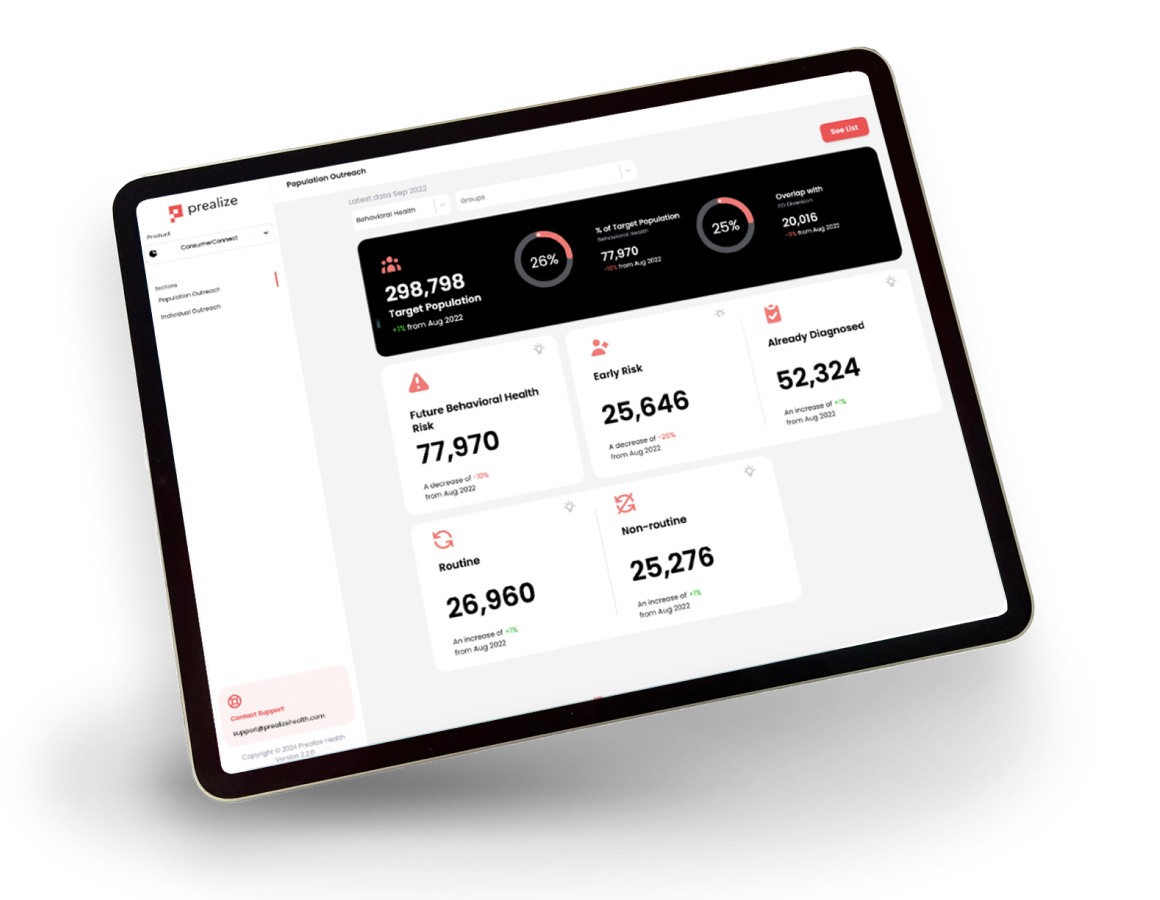
The Industry’s Evolving Approach to Addressing Social Risk Factors Through Proactive Care Delivery
Written by: Gordon Norman, MD, Chief Medical Officer, Prealize Health
While industry conversation around social determinants of health (SDoH) has been prolific over the last several years, the subject is not a new one for clinicians or public health leaders. In fact, that social conditions and disparities greatly influence population health status has been understood by health care practitioners since the early 19th century. These factors fully emerged in public discourse in 1948 when the newly formed World Health Organization (WHO) defined health in comprehensive terms, as “a state of complete physical, mental and social well-being.”
A brief history: how social risk emerged as a primary factor in overall health
In the decades since the WHO’s landmark definition, the industry has consistently evolved its approach, from expanding the working definition of primary care, to calculating the economic impact, and ultimately developing a comprehensive framework for the advancement of health equity to improve outcomes for every American. The timeline below outlines the industry’s major milestones in approaching the outsized impact of social factors on healthcare, and strategies to advance health equity nationwide.
| A brief history: The evolution of public health discourse around the intersection of social factors and overall health Primary care, expanded: By the 1970s, the WHO was reinforcing the importance of social factors in primary health care by calling for greater attention to coordinating food, education, housing, and public services in addressing population health needs Calculating the economic impact: In the early 2000s, the economic impact of SDoH was being quantified for the first time. Since then, these factors have been a part of nearly all public health discussions and many policiesPandemic as accelerant: COVID-19 emerges in mid-2020 and the resulting stresses on our healthcare system (specifically, widespread illness and hospitalizations overwhelming existing resources, coupled with lockdowns and social distancing practices) underscores the impact of SDoH on long-term health CMS releases a framework: In response, in 2021, CMS issues an explicit “roadmap” designed to help states address SDoH in order to improve outcomes, lower costs, and support state value-based care strategies A strategy emerges: In 2022, CMS follows up with an expansive Framework for Health Equity, an approach for the coming decade 2022-2032 which targets five health equity priorities and expands the notion of SDoH from a localized phenomenon to a broad societal disparity issue |
Last year, the topic received its most expansive treatment yet, as the CMS released a focused, decade-long approach within their Framework for Health Equity: 2022–2032. This guide outlines a playbook for the top five health equity priorities, summarized below:
- Priority 1: Expand the Collection, Reporting, and Analysis of Standardized Data
- Priority 2: Assess Causes of Disparities Within CMS Programs and Address Inequities in Policies and Operations to Close Gaps
- Priority 3: Build Capacity of Healthcare Organizations and the Workforce to Reduce Health and Health Care Disparities
- Priority 4: Advance Language Access, Health Literacy, and the Provision of Culturally Tailored Services
- Priority 5: Increase All Forms of Accessibility to Health Care Services and Coverage
Leveraging data to develop personalized approaches to population healthcare
Research demonstrates that SDoH have an outsized impact on population health, driving an estimated 80–90% of long-term health outcomes. Social determinants, including transportation risk, food access risk, access to quality education, and safe living environments, contribute to the likelihood of adverse outcomes—and may compound the ability to mitigate the risk of chronic conditions and other individual health episodes.
Until very recently, it was difficult for providers to know the particular factors that contribute to risk or complicate care. With the advancement of regular SDoH screenings and advanced predictive analytics, health plans and provider organizations can leverage advanced predictive analytics to forecast risk over six, twelve, and eighteen month intervals. This proactive knowledge can equip stakeholders on two different levels: an individual—or micro level—and a population health—or a macro level.
On a micro level, predictive analytics can help care providers focus on the populations most at-risk for certain costly care episodes. WIth this knowledge, plans and providers can prioritize the individuals who are the best candidates for immediate intervention, based on both their personal risk and contributing SDoH factors. The specific level of these insights enable care managers and clinicians to determine the most appropriate type—and timing—of intervention that is most likely to make a difference in each individual’s care plan and long-term prognosis.
On a broader population health level, the lens of predictive data on social risks can help define actionable strategies in the community. Health plans and provider organizations can partner with local, community-based organizations and social agencies to develop tangible resource networks and action plans that break barriers to care and help fill gaps in social risk.
What’s next for healthcare?
| Proactive Identification Drives Earlier Intervention—and Healthier Populations Our most recent report, Spotlight on Social Determinants of Health, outlines the impact of social risk factors on outcomes and risk needs for individuals across insurance types within four main service line areas: cardiovascular health, behavioral health, musculoskeletal health, and maternal health. Read the report to learn the primary non-clinical risk factors that contribute to adverse outcomes and growing risk in these four costly care categories—and for proactive strategies to help identify, address, and intervene for healthier people and healthier populations. |
For the first time, predictive analytics make addressing SDoH a practical reality, instead of merely a desirable goal. As regular screening and data collection becomes more standardized, the resulting robust contextual patient information can finally be leveraged for proactive care planning that takes into account the entirety of an individual’s care profile, from medical history and clinical risks to personal economic, resource, and social factors that coalesce for a full picture of health.
Stay tuned for the next blog in our series, a treatment of the clinical perspective on SDoH risk factors within clinical care—and how actionable interventions powered by predictive analytics will help redefine the shape of healthcare for decades to come. In the meanwhile, download a free copy of our latest report to learn more.

Experience the Prealize Difference
We invite you to experience the transformative power of unparalleled accuracy. Request a demo today and see how Prealize can empower your organization to achieve better health outcomes, reduced costs, and a new era or proactive care.